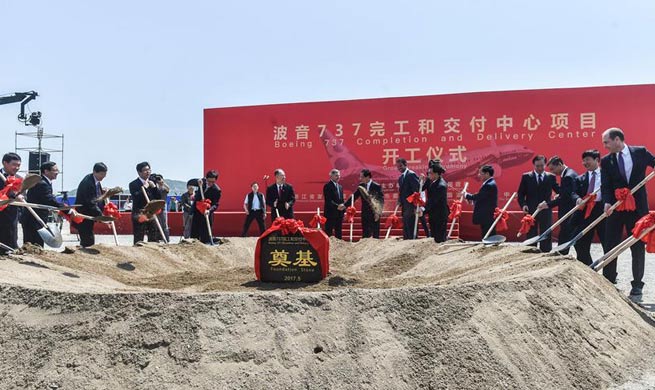by Xinhua writers Zhu Dongyang, Kan Jingwen
BEIJING, May 12 (Xinhua) -- As China moves forward in the carrying out its ambitious and grand Belt and Road Initiative, Chinese workers have become no strangers to the countries sitting along the centries' old trade route, and the peoples living there. Chinese builders are playing a crucial role in creating what could amount to the greatest economic project of the century.
A 20S GAUGER IN ALGERIA'S ROUGH TERRAIN
In Algeria, the largest country in Africa, a young Chinese construction team from the China State Construction Engineering Corporation (CSCEC) are building a highway that penetrates the Atlas Mountains, a vertical project that links the Mediterranean with the Sahara.
Among the workers was Yang Yang, a gauger in his 20s that has worked on the project since 2013.
The complicated landforms has made the highway the most difficult task among Algeria's infrustracture projects. Yang led his fellow workers to trudge through the dangerous canyons of Atlas every morning, however severe the weather is or difficult the terrain.
Yang knows the importance of his job to the whole project -- just a tiny error could result in tremendous losses. He had racked his brains in programming -- only with the help of a calculator and a computer -- and made to ensure the accuracy and efficiency of data.
As the saying goes, no pain, no gain. Tunnel 2 was successfully integrated into the mainbody of the highway on Dec. 15, 2016. With a length of 2,425 meters, the project was Algeria's longest highway tunnel to date.
A POWER PROVIDER IN GUINEA'S BROILING HEAT
The stamp of "Made by China" has been engraved in the west corner of Africa.
About 150 km northeast from Conakry, capital of Guinea, a big waterfall appears above the Konkoure River. This is the Kaleta Hydropower Station, a power-supplying project built by China International Water and Electric Corporation (CWE) -- in merely three years.
"As builders, we have to work in the heat. Our hair is always wet, and after a day's work, our clothes are soaked through with sweat," said Wang Xiaoyi, a Kaleta worker.
The torridity afflicted the Chinese workers at night. Their temporary dorms were pretty poorly equipped, and their mini generator could not offer enough electricity for air-conditioners or electric fans, which made it more difficult to fall asleep.
But Wang tells himself to carry on. "Think of the people that live in darkness, and I said to myself: be a candlelight to them."
Now, after supplying enough electricity to the capital and 11 provinces, the station was given a new mission: to produce electricity for neighboring countries such as Gambia, Senegal, Mali and Guinea- Bissau in the near future.
On the same river 135 km away from Conakry, the even larger Souapiti Hydropower Station was being built by the CWE. Upon completion, Guinea, a country once short of power, will become a power exporter in West Africa.
"CHINESE MASTERS" IN CAMBODIAN LAND OF DESOLATION
Across the Indian Ocean, light has illuminated a land of desolation in the Southeast Asian country of Cambodia.
Stung Russei Chrum, a river running through the uninhabited valley in the country's southwest, had seen nothing but a "lonely island" excluded from the national electricity grid until 2010, when China Huadian Corporation (CHD) began to build the biggest hydropower plant in Cambodia.
The construction of the plant was completed nine months ahead of schedule, quite a feat considering the difficulties confronting the Chinese workers -- minefields, rainstorms and a continuous lack of technicians.
"We had hand grenades dug up in construction sites even after the United Nations personnel demined the area," said Le Jianhua, head of the project, referring to a nearly 30-year civil war that officially ended in 1999.
Cambodian Minister of Mines and Energy Suy Sem spoke highly of the Chinese expertise, hard work and friendly cooperation with the Cambodian side during and after the construction.
"Without them, things would not have been done so smoothly, and the cost would have been much higher," he said.
With an installed capacity of 338 megawatts, the project has provided almost half of Cambodia's on-peak power demand in 2013.
At the official launch ceremony in January 2015, Prime Minister Samdech Techo Hun Sen highlighted the project as a significant contribution to Cambodia's economic growth, social development and poverty reduction.
Keat Makara, a Cambodian college graduate who works as an operation supervisor of this project, has been eager to learn from the training and modern cooperate management offered by the Chinese.
"We lack experience, so we need to learn from the Chinese," he said in fluent Chinese.
In fact, the plant was among the six hydropower plants the CHD has helped build and run for Cambodia since 2000. Together they supply 47 percent of Cambodia's power, benefiting 72 percent of its villages.
However, the mission of the CHD is far from being finished, at least in Le's eyes.
"We have yet to train the Cambodian staff and help establish a management system as well as professional codes and standards," Le said. "It's all for the plant's future development."


















